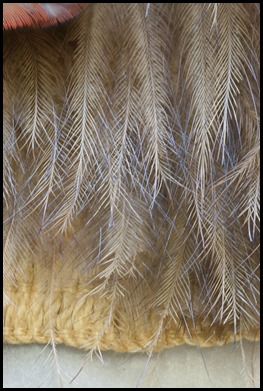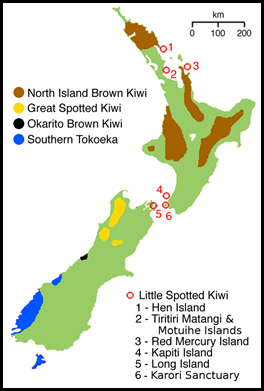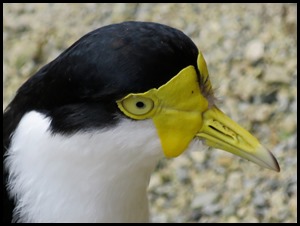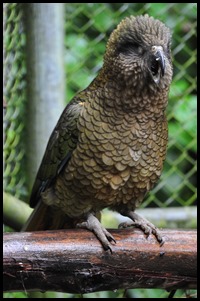Kiwi House Part 1

|
Our Visit to Kiwi House – Peter, Atu and More – Part
One
Of course he did. No sooner than he saw the welcoming kiwi, than in a split second the firing finger got into position. One of the ladies was outside and told us kea feeding was soon, enough time to look at Atu before bimbling over to the kea aviary.
Peter, the brown kiwi, are we talking cute ??? Super cute ??? or Mega cute ????
We stood and watched Atu, the spotted kiwi for quite a while, she ran up and down, scruffing and digging. Such a comical bird, it would not be strange if as a species they had two front legs and lopped along on all fours. In some ways they look like a stooped elderly gentlemen using their beak like a walking cane.
Imagine a bird that cannot fly, with skin as tough as leather, feathers like hair, cat-like whiskers on its face and excellent hearing. The only bird in the world with external nostrils at the tip of its beak and an acute sense of smell. It nests in burrows, lays large eggs, is territorial and aggressive. Heavy legged, large clawed, seen as clumsy and daft. The kiwi.
We emerged from the dimly lit kiwi house and there in our way was Thora. One of the keepers warned us that if she took a shine to us she would act as our official guide, the first thing was to stop her shouting at us...........
Thora was indeed going to stay with us. She stopped shouting and posed happily, this way and that, and let us get very close for a picture of her spur. The masked lapwing (Vanellus miles), previously known as the masked plover and often called the spur-winged plover or just plover in its native range, is a large, common and conspicuous bird native to Australia, particularly the northern and eastern parts of the continent. It spends most of its time on the ground searching for food such as insects and worms and has several distinctive calls. We thought someone had gone mad sticking and gluing bits of yellow Marigold gloves, but didn’t let on to Thora in case we offended her.
The keeper found us and took us on a short cut to the keas. Thora caught up and was clearly not pleased at our breaking ranks, shouting her disapproval. The keeper introduced us to Mati – meaning digit or claw – the lady on the left - is blind in her right eye but apparently very bossy. Zeppy, named after Led Zeppelin is learning to sing like his mate. It is coming up to breeding season so they have this enclosure to themselves.
We found ourselves being really studied by Zeppy, before food took his attention. He singled out all the chunks of banana first, then took apart the carrot with great gusto. The Kea or Mountain Parrot are one of the most intelligent and inquisitive parrots in the world Enthusiastic omnivores they will investigate anything that looks like food. Although thought of as a mostly alpine bird, they can be found from coastal forests right up to the alpine tussock lands of the Southern Alps. Because of the rough terrain they live in the number of Kea are hard to estimate with figures ranging from as low as a thousand up to five thousand. Despite really protective parenting only 40% of kea will make it to their first birthday. Possums and stoats are the main killers, but some birds become too fond of human habitats and make themselves ill gorging on tidbits from ski fields and rubbish bins. We look forward to seeing them in the wild, but, they can be destructive like the monkeys in Longleat, pulling off windscreen wipers and hacking through spare tyre covers with their mammoth beaks.
The keeper put a variety of vegetables in a dangling basket. Within a minute Zeppy had landed on the branch, pulled the chain up, held it with his foot, pulled more chain which he looped on a nut sticking out from the branch, then he held the basket with his foot and set about working a cabbage leaf out of the gap at the top. Meanwhile, Mati had put her full weight on a step, this opened the lid on a food trough now filled with goodies.
Food finished for now, Mati stood and screamed, Zeppy shook his tail feathers, she continued to scream and he continued to waggle. Don’t think Bear will be allowed one of these, the noise is immense and Beez teak wouldn’t like those beaks.
Next door were Kaka, found on both main islands and more abundantly on some off-shore islands, the kaka is now confined to the few tracts of native forest. They nest deep in the hollows of native trees, they lay up to five eggs which take approximately twenty four days to hatch. Both parents feed the young who leave the nest in nine or ten weeks. More often heard than seen, with a loud harsh, grating call ringing out from high in the trees. It feeds on berries, nectar, insects and their larvae. Kaka numbers are threatened by the clearing of their natural habitat. Toki – meaning chopper, is a rescued male who can no longer fly but is well known for the damage he does to the branches. He hung above the keeper, stretched to his full length, delicately took the offered cashew, held it in his beak, bimbled down the side of the flight, settled on a branch, transferred the nut to his claw and daintily ate his food. When he had finished he reversed his route and waited patiently for another nut, this time he was offered an almond, not good enough, he let that drop to the floor. He wanted another cashew. Said performance was repeated, complete contrast to his messy neighbours, the kea.
Rata has flown in from Auckland Zoo and enjoys perching on the keepers’ shoulders, here he is happily sitting on the edge of the food bowl, like Toki, very gently choosing his food in his beak and transferring it to claw.
ALL IN ALL FUN BUSINESS |
























